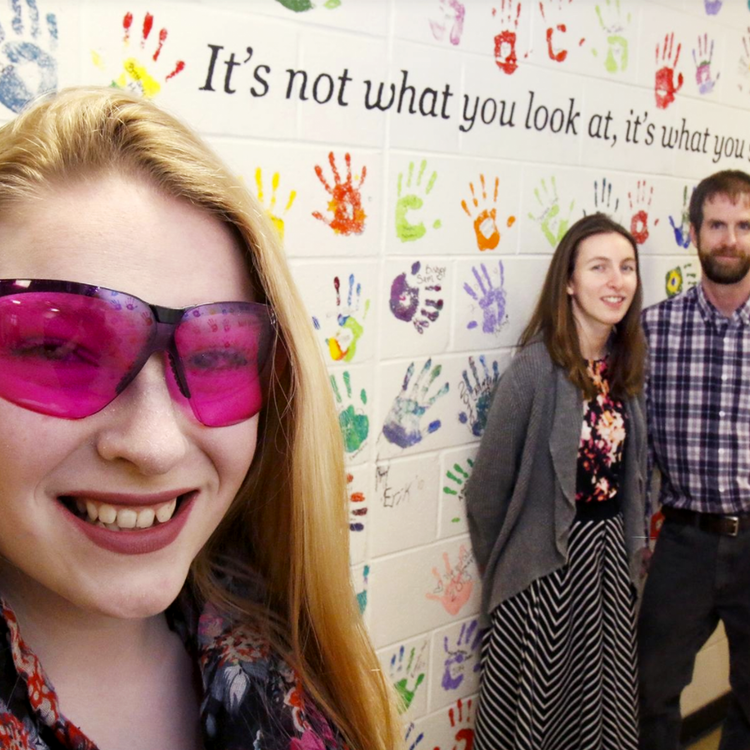
WEBSTER – Bartlett High School’s art department received $5,000 from the Janet Malser Humanities Trust to buy six pairs of corrective glasses for students who are color-blind.
The department then created the Janet Malser Color Blind Corrective Glasses Library, so that color-deficient students could borrow glasses for use in school, on school trips and at home.
The use of a particular brand of glasses, called Vino Optics, was so good for recent graduate Brianna Doherty, who can’t see reds and greens, teachers used their own money to buy a pair for her to keep.
Brianna, a 19-year-old freshman at Nichols College in Dudley, recently expressed gratitude to Bartlett art teachers Brittany Gyllenhammer and Sean Harrington, as well as the scientist who created the glasses.
Brianna was introduced to the Vino Optics during the fall, when she borrowed a pair for a month. She said she was “heartbroken” having to return them.
The newfound ability to see bright colors was so profound for Brianna, who studies accounting and math, she made a video that she posted online.
STORY CONTINUES BELOW VIDEO
The video shows Brianna excited about differentiating hues of lipstick, the brightness of a car, and during a visit to the produce section at a local grocer.
Mr. Harrington said the art department bought the glasses for $300 each. But he recently found out the price had dropped to $200, and so he, Ms. Gyllenhammer and other Bartlett teachers chipped in to get a pair of Vinos for Brianna and another student.
“I can’t even describe it,” Brianna said of the glasses. “It’s a completely new feeling.”
Brianna attended Bartlett from Grades 7 to 12. The campus has a tree that gets big with colorful leaves in the fall. Every year, Brianna said other students talked about how beautiful the tree was. But she never thought anything of it.
Seeing the tree through the new glasses is “jaw-dropping,” she said.
Vino Optics was created by 2AI Labs scientists Tim Barber and Mark Changizi.
Ms. Gyllenhammer, Mr. Harrington, Brianna and a reporter participated in a conference call Wednesday with Mr. Changizi, a Miami-based neuroscientist. Mr. Changizi explained how the glasses were developed.
He said that most mammals, such as dogs, rabbits and horses, have just two dimensions of color. There’s a yellow-blue scope and another for brightness.
Humans, however, have an extra red-green dimension, he said.
Mr. Changizi found that the long-held theory that color vision evolved to help primates find fruits in the forests was never a good argument. That’s because primate diets vary among those who have the three-dimensional color vision that humans possess.
In 2006, Mr. Changizi resolved that primates’ color vision evolved by being able to see blood under the skin to sense emotions and health. His discovery helped understand that color vision allowed humans to read one another by seeing into their underlying physiological state. This led to the design of the glasses.
“It turns out I was able to show that the kind of peculiar color vision we have is exactly the kind of peculiar color vision” one needs to see blushing, veins and all color modulations on bare skin, he said.
“It’s actually optimized to see the oxygenation modulations of hemoglobin under the skin, so that you can see the psychological state, the emotions of others,” he said.
To that end, the glasses were originally designed to target helping medics, nurses and doctors who couldn’t see veins, cyanosis and “the kinds of things in rashes that everyone takes for granted, that color blind folks are missing.”
The scientists realized they could help color-blind people, by blocking narrow bands of wavelengths that are counter signals, or what Mr. Changizi called “bad signals” for seeing the oxygenation signals.
“By blocking certain bands that are counter signals, you can actually enhance the signal that red-green vision is for, and we came up with a couple of different technologies that do that, and so it occurred to us we could help color blind people,” he said.
During the conference call, Brianna thanked the creator for making the glasses and “giving so many people the opportunity to see,” which she said meant a lot.
Mr. Changizi returned the compliment. He said he viewed Brianna’s video. “You have a career ahead of you in directing,” he said.
Meanwhile, the Bartlett art teachers say they have six or seven color-blind students.
“We had some painting and ceramic students that expressed to us that they were having some difficulty mixing colors,” Ms. Gyllenhammer said. “And so we tested the students to see if they had any color-blind issues, and they did, which prompted us to then see if we had more students and more community members that had color blindness.”
That’s when Mr. Harrington applied for the Malser grant, which was originally aimed to buy six pairs of a different type of corrective glasses, called En Chroma, at $350 apiece.
Mr. Harrington said he saw a piece about En Chromas on the Today Show.
He said he returned four pairs of the En Chromas after realizing there were other brands such as the Vinos, and because the kids hardly got anything out of the En Chromas, he said.
About 70 percent of those who tried the Vinos, on the other hand, found “dramatic” results, Mr. Harrington said.
Mr. Harrington said a number of adults, including coaches, reported good results when they borrowed the glasses.
Being able to help students “in a medical way” is profound, he said.
“It was one of the better feelings, after teaching art for 26 years, to help students like this see color,” Mr. Harrington said. “Color is really important in art.” He said he hadn’t thought about it much earlier in his career. “It wasn’t like we had tons of color-blind students,” he said.
Mr. Changizi also talked about the “disproportionate issues” color blindness presents for artists.
“Colors are one of the most evocative kinds of stimuli that artists play with,” he said.
The Malser grant for correcting color-blindness includes funds for two “colorful” field trips for art students. They went to the Normal Rockwell Museum in Stockbridge last fall and viewed foliage along the way. Next month, the program will visit the Metropolitan Museum of Art in New York City, and Central Park “to experience spring colors and flowers and stuff,” Mr. Harrington said.
Janet Malser, a lifelong resident of Dudley and Webster, established the trust to advance her love of art, humanities, community service, and conservation.
Originally published by Telegram.com


Be the first to comment